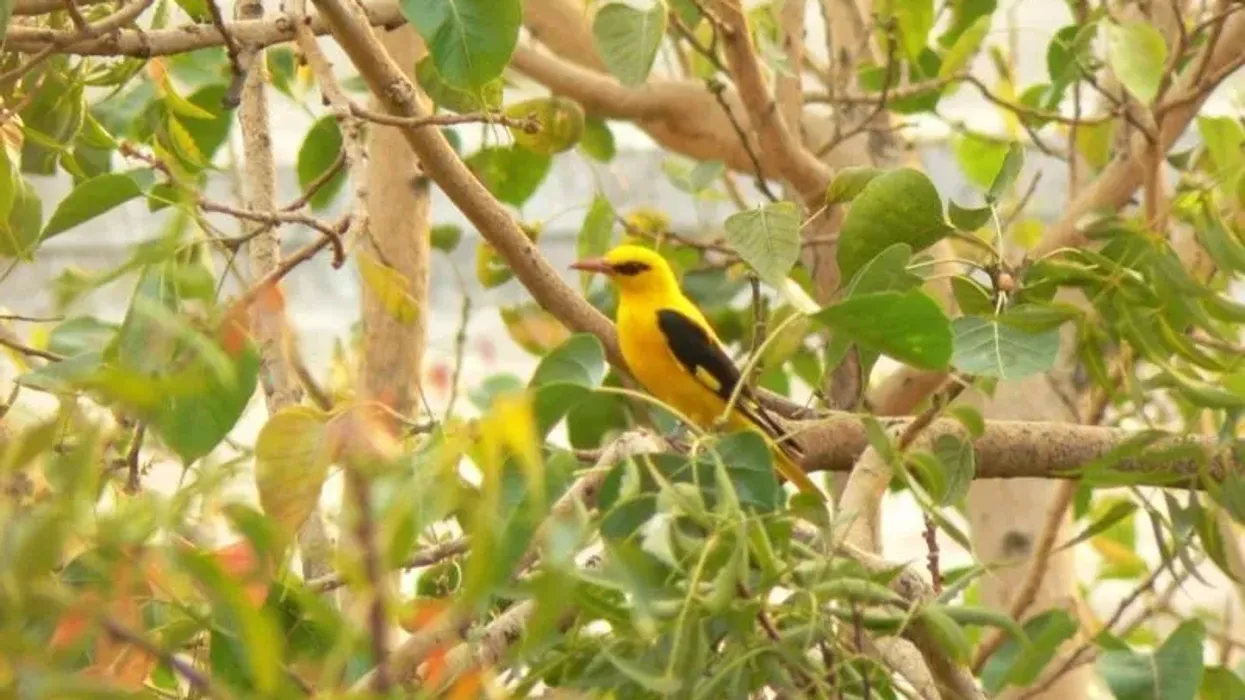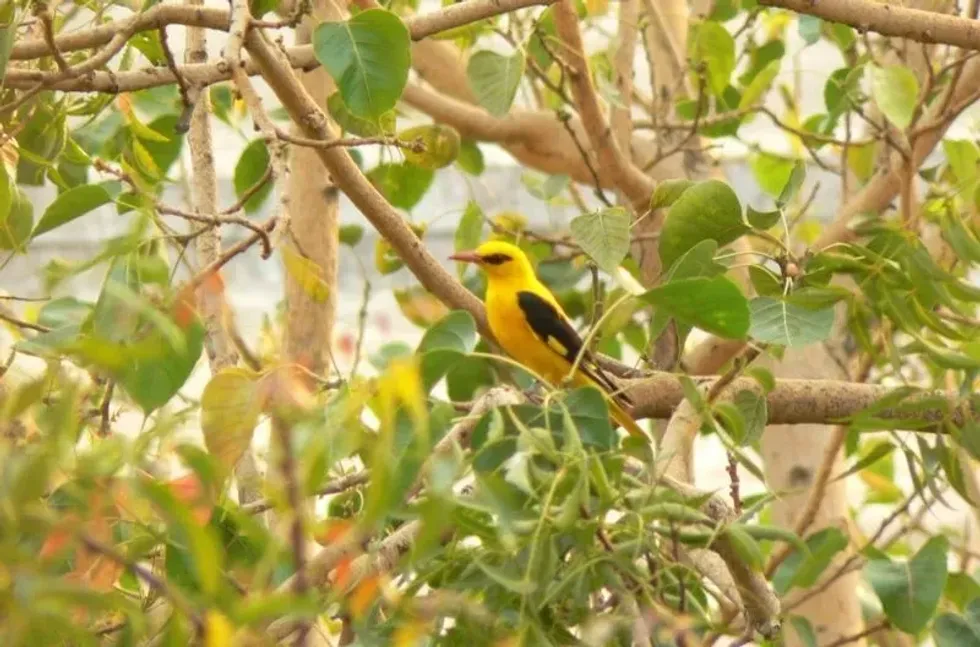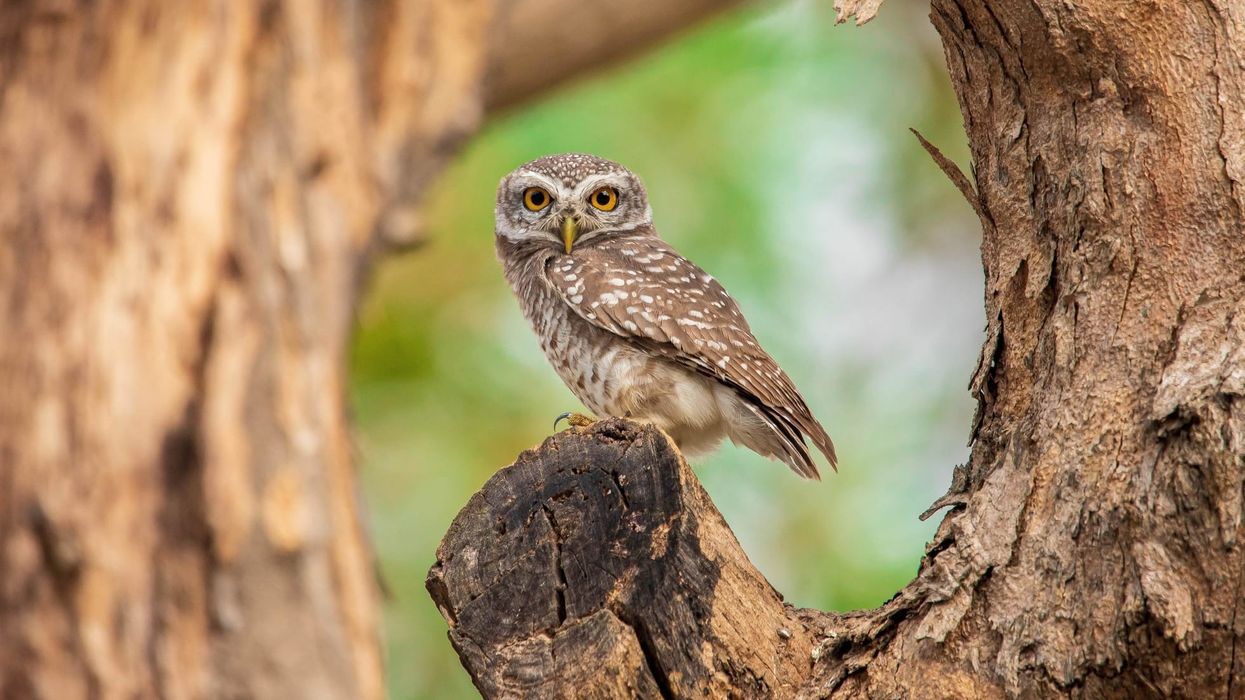The Indian golden oriole (Oriolus kundoo) was treated as a subspecies of the Eurasian Golden Oriole for a long time. It was in 2005 that John Anderton and Pamela Rasmussen decided to assign this bird as a distinct species in their book ‘Birds of South Asia’.
This book consists of over one thousand species of birds from different regions. A phylogenetic study conducted in 2010 published an elaborate analysis supporting this statement.
And, since then many ornithologists have considered this as an independent species.
The Indian golden oriole differs from the Eurasian Golden Oriole in various aspects including their eye patch, feathers, and bill. The Indian golden oriole is monotypic, its distribution and habitat encompass the territories of India, Sri Lanka, Nepal, Bhutan, Afghanistan, Baluchistan, and others.
Primarily yellow these Passeriformes are moderately common. This bird is a partial migrant as only the birds that can be found in Indian are residents while the rest of the population is migratory.
To learn more about this the Indian golden oriole keeps reading this article as more interesting facts about this bird species are stated below.
If you like this article then definitely check your other articles on blue jay and umbrellabird and share the facts with everyone.
Indian Golden Oriole Interesting Facts
What type of animal is an Indian golden oriole?
The genus Oriolus consists of almost 30 breeds and the Indian golden oriole (Oriolus kundoo) is one of them.
What class of animal does an Indian golden oriole belong to?
The Indian golden oriole (Oriolus kundoo) belongs to the class of Aves, family Oriolidae, and genus Oriolus.
How many Indian golden orioles are there in the world?
The distribution of the orioles is huge therefore the total number of these birds present in the world is not listed. The population is however stable and they are not under any threat.
Where does an Indian golden oriole live?
The Indian golden oriole range map covers a vast portion of Central Asia and the Indian Subcontinent. These orioles can be found in the hills of Baluchistan, Northern and Eastern Afghanistan, Uzbekistan, Southeastern Kazakhstan, Kyrgyzstan, Eastern Turkmenistan, China, Nepal, Bhutan, Northern India, Sri-Lanka.
What is an Indian golden oriole's habitat?
The Indian golden oriole habitat can be described as an open forest. The populations of these orioles reside in the semi-evergreen forests also in the thorny forests and deciduous forests.
The nests are mostly built by females while males bring raw materials that are required to construct the nest. Males bring barks, cobwebs, leaves, green stems, and other things to build an open cup-like nest where the females can lay eggs.
Who do Indian golden orioles live with?
The Indian golden oriole (Oriolus kundoo) primarily forage in groups, alone, or in pairs. Nevertheless, the description of their social behavior has not yet been documented.
How long does an Indian golden oriole live?
The lifespan of the Indian golden oriole (Oriolus kundoo)is not listed. However, the other species of the Oriole such as the Eurasian can live up to 8-12 years.
How do they reproduce?
The breeding season of these orioles depends on the location. For example in Afghanistan the breeding season is June. In Nepal, it is from may-June, and in India, it is from April-September.
A large part of the male population arrives earlier than females. Males continuously call on the vicinity and chase females actively.
Then they copulate and the average clutch size is 1-5 eggs. The incubation period of the orioles is 14-15 days. Both parents feed and take care of the young ones after birth till they are ready for fledging.
What is their conservation status?
The conservation status of the Indian golden oriole (Oriolus kundoo) according to the International Union for the Conservation of Nature is of Least Concern. They are widely seen in their local habitat and have a steady population, hence they are not rare.
Indian Golden Oriole Fun Facts
What do Indian golden orioles look like?
The Indian golden oriole (Oriolus kundoo) of order Passeriformes is acknowledged for its vibrant color and unique characteristics. These are moderate oriole with an approximate length of 9.4-9.8 in (24–25 cm) and a weight range between 2.1-3.4 oz (60–95 g) this bird is a common breed.
The adult Indian golden oriole male has generally golden yellowish plumage. They resemble the Eurasian golden oriole, However, the Indian golden oriole is more yellow near its tail.
Male orioles have a black streak that extends from their eye to the back of the head. The upper portion of their wing is velvety black with wide yellow tips.
The Indian golden oriole tail is also black with thin yellow tips. The bill of these orioles is longer than the Eurasian species. The eye of the Indian golden oriole is red and the bill is deep pink.
Females are yellowish-green with a brownish or wine green tail. The Indian golden oriole female has more sharp streaks than the Eurasian breed.
The area from their chin till the upper part of the breast is gray, and this belly is yellowish-white. The Indian golden oriole juvenile also has golden-yellow plumage and a black bill.

How cute are they?
The Indian golden oriole (Oriolus kundoo) are small bird. The vibrant golden yellow plumage makes these orioles even more adorable.
How do they communicate?
The Indian golden oriole (Oriolus kundoo) uses various calls to communicate with each other. Their calls are comprised of a different set of melodious tunes. These calls are partly similar to the Eurasian Golden Oriole as the Indian species have a more complex narrow pitch that is very very long.
How big is an Indian golden oriole?
The Indian golden oriole (Oriolus kundoo) is almost 9.4-9.8 in (24–25 cm) in length. This woodland bird is slightly bigger than the hooded oriole which is 7.1-7.9 in (18-20 cm).
How fast can an Indian golden oriole fly?
The speed of the Indian golden oriole (Oriolus kundoo) can reach as much as 25 mph (40.2 kph). The species of bird is not completely migratory. They move locally in search of food.
The movement of the birds plays a crucial role in the ecosystem. The diet of these birds consists of various berries and fruits that contain seeds. Thus they are responsible for the dispersions of seeds in various parts of their habitats.
How much does an Indian golden oriole weigh?
The weight of the Indian golden oriole (Oriolus kundoo) is approximately 2.1-3.4 oz (60–95 g).
What are the male and female names of the species?
The name for the male and female Indian golden oriole (Oriolus kundoo) is not listed.
What would you call a baby Indian golden oriole?
The name for the baby of the Indian golden oriole (Oriolus kundoo) is not listed. However, before becoming an adult a bird goes through different phases while some breeds of birds have a special name for their babies.
Newly hatched birds from eggs with no feathers are called hatchlings.
Then these hatchlings are called nestlings this stage is when they cannot leave their nest and the last stage is fledging when they develop feathers and are ready to leave their nest. The juvenile bird is not an adult but it is not dependent on its parents either.
What do they eat?
The Indian golden oriole diet consists of primarily berries, invertebrates, insects, nectar, bugs thus these birds are omnivores. Berries like mulberries, cherries, figs, neem, and fruits especially mango. A large part of the population feeds on various invertebrates including spiders, cicadas, praying mantis, beetles, grasshoppers, ants, bugs, and occasionally on lizards.
Are they poisonous?
No, the Indian golden oriole (Oriolus kundoo) is non-poisonous.
Would they make a good pet?
The Indian golden oriole (Oriolus kundoo) is a partial migrant species, unlike the Eurasian species. Even though this species is common yet they are not being kept as a pet. The reason is unspecified, it could be that these birds do not do well in captivity.
Did you know...
In 1832, William Henry Sykes an English naturalist first described the Indian golden oriole (Oriolus kundoo) and gave its scientific name. Although he characterized this bird as a distinct species yet it was treated as a subspecies of the Eurasian golden oriole.
Is golden oriole a migratory bird?
The golden oriole is also known as Eurasian golden oriole is a migratory bird that is under seasonal migration particularly during autumn, spring, and winter. They have a similar kingdom, class, order, family, genus as the Indian golden oriole (Oriolus kundoo).
However, the Eurasian species generally migrate during the night. From July-September these orioles migrate to East Mediterranean.
During winter the populations again migrate to Southern regions and enter the Central African Republic and Cameroon. Their spring migration commences in February during this period numerous birds migrate as far as Eastern and Western Morrocco. They arrive at their Palearctic breeding area by April-May.
Females arrive late than males. The ideal habitats for this species incorporate open woodland with tall trees, groves, orchards, gardens, and other places.
Are Indian golden orioles endangered?
No, the Indian golden oriole is not an endangered bird species. The conservation status of this bird is confirmed to be of least concern as the population size is satisfactory.
The distribution and habitat are inclusive of large areas and some of the areas are even protected. The Indian golden oriole (Oriolus kundoo) is comparatively common in its local habitat.
Here at Kidadl, we have carefully created lots of interesting family-friendly animal facts for everyone to discover! For more relatable content, check out these vesper sparrow facts and blackpoll warbler facts for kids.
You can even occupy yourself at home by coloring in one of our free printable bird coloring pages.








